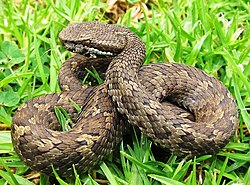| Image | Species | Taxon author | Subsp.* | Common name [1] | Geographic range |
|---|
| C. anamallensis | (Günther, 1864) | 0 | Malabarian pit viper | India |
 | C. andalasensis | David, Vogel, Vijaykumar & Vidal, 2006 | 0 | Sumatran palm pit viper | Indonesia: Sumatra. |
| C. borneensis | W. Peters, 1872 | 0 | Borneo pit viper | Indonesia: Borneo. |
| C. brongersmai | Hoge, 1969 | 0 | Brongersma's pit viper | Indonesia: Simalur Island. |
 | C. gramineus
type species | Shaw, 1802 | 0 | Common bamboo viper | Southern India. |
 | C. macrolepis | Beddome, 1862 | 0 | Large-scaled pit viper | The mountains of southern India. |
 | C. malabaricus | Jerdon, 1854 | 0 | Malabarian pit viper | Southern and western India at 600–2,000 m elevation. |
| C. occidentalis | Pope & Pope, 1933 | 0 | | India |
| C. peltopelor | Mallik, Srikanthan, Ganesh, Vijayakumar, Campbell, Malhotra, & Shanker, 2021. | 0 | | India |
 | C. puniceus | Boie, 1827 | 0 | Ashy pit viper, flat-nosed pit viper | Southern Thailand, West and East Malaysia (Sabah and Sarawak) and Indonesia (Borneo, Sumatra, the Mentawai Islands of Siberut and North Pagai, Simalur and Java. |
 | C. strigatus | Gray, 1842 | 0 | Horseshoe pit viper | The hills of southern India. |
| C. travancoricus | Mallik, Srikanthan, Ganesh, Vijayakumar, Campbell, Malhotra, & Shanker, 2021 | 0 | | India |
 | C. trigonocephalus | Donndorff, 1798 | 0 | Ceylon pit viper, Sri Lankan green pit viper | Throughout Sri Lanka from low elevations to about 1,800 m. |
| C. wiroti | Trutnau, 1981 | 0 | Wirot's pit viper | Thailand, West Malaysia. |







